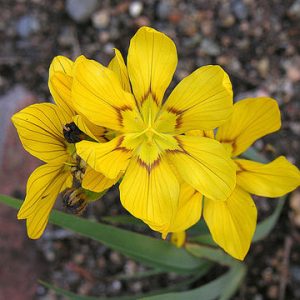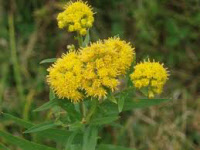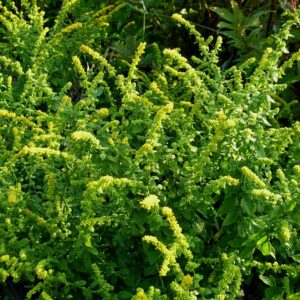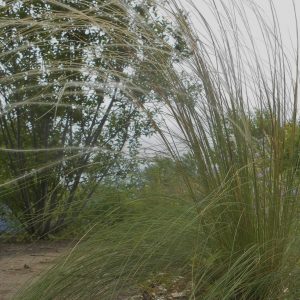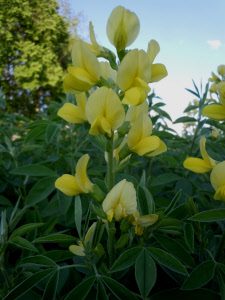Archives
Showing 145–152 of 164 results
-
Sisyrinchium macrocarpum Argentinian blue-eyed grass Z 5-9
In summer large yellow cups with red line encircle the center, above petite iris-like foliage
ARCHIVED
Note: This is a plant not currently for sale. This is an archive page preserved for informational use.
In summer large yellow cups with red line encircle the center, above petite iris-like foliage.
Size: 6-12” x 9-12”
Care: sun in moist well-drained soil
Native: Argentina’s central & southern cordillerasDescribed in 1881.
-
Solidago graminifolia Grass-leaved goldenrod Z 3-9
Golden flat-topped inflorescences August to October, loved by butterflies for its nectar.
ARCHIVED
Note: This is a plant not currently for sale. This is an archive page preserved for informational use.
Golden flat-topped inflorescences August to October, loved by butterflies for its nectar.
Size: 2-3' x 1-2'
Care: sun in moist to moist well-drained soil, Deer resistant.
Native: Nova Scotia across Canada, S. to FL., Wisconsin native
Wildlife Value: loved by many butterflies for its nectar – Small copper, Monarch,Giant swallowtail, Gray hairstreak, Clouded Sulphur, Fritillary, Pearl crescent, & Cloudless sulphur. Attracts praying mantises; Deer resistant.The name Solidago from solidus and ago meaning to “bring together.” Gramnifolia means “grass-leaved.” Since 1750’s.
-
Solidago sphacelata ‘Golden Fleece’ Golden Fleece Goldenrod Z 4-8
Dense horizontal golden panicles on this dwarf Goldenrod, August to September
ARCHIVED
Note: This is a plant not currently for sale. This is an archive page preserved for informational use.
Dense horizontal golden panicles on this dwarf Goldenrod, August to September
Size: 12-18” x 24”
Care: full sun to part shade in moist well-drained to well-drained soil
Native: selection of species SE US
Wildlife Value: Butterfly magnet Monarch, Viceroy & Painted ladies
Awards: Winner Missouri Botanic Garden Award of Merit & Cornell University Allstar. Internationale Stauden-Union’s Award for outstanding new plant in Switzerland in 1994.Solidago from solidus and ago meaning to bring together. Species collected by 1800’s and named by Rafinesque but this short form was found in 1985 in Eden North Carolina. OK, it’s not really old (middle aged) but it is so different from all other Goldenrods that I couldn’t resist.
-
Stipa tirsa Horsetail feather grass Z 5-8
Thinnest of thin, white-silver panicles from thin green leaves June-July
ARCHIVED
Note: This is a plant not currently for sale. This is an archive page preserved for informational use.
Thinnest of thin, white-silver panicles from thin green leaves June-July
Size: 18-24” x 14-20”
Care: sun in well-drained soil
Native: Europe, Siberia, Russia and Caucasus1st described in Bulletin de la Société Impériale des Naturalistes de Moscou 30(2): 115. 1857.
-
Syringa vulgaris Lilac, French lilac Z 4-8 SHRUB/SMALL TREE
Single or double, very fragrant lilac panicles in late spring
ARCHIVED
Note: This is a plant not currently for sale. This is an archive page preserved for informational use.
Single or double, very fragrant lilac panicles in late spring
Size: 20’ x 15’
Care: full sun in well-drained soil
Native: SE Europe, Caucasus to AfghanistanIntroduced to European from its native Turkey by Viennese ambassador De Busbecq (1522-1592). Grown in Jefferson’s garden at Monticello and Washington’s Mount Vernon. By 1850 “found in almost every (American) garden.” Breck (1851) ‘Alba’ listed in Tradescant the Elder’s 1634 list as “Lilac Matthioli.” Elias Ashmole’s manuscript, “trees found in Mrs. Tradescants ground when it came into my possession (1662) as ‘Syringa alba.’ ” Pressed specimen in Emily Dickinson’s herbarium.
-
Thermopsis caroliniana syn. Thermopsis villosa Carolina lupine Z 4-9
Dense spikes of buttery yellow in June, resembling Baptisia or Lupin with clover like foliage.
ARCHIVED
Note: This is a plant not currently for sale. This is an archive page preserved for informational use.
Dense spikes of buttery yellow in June, resembling Baptisia or Lupin with clover-like foliage.
Size: 4’ x 2’ spreading
Care: Sun in well-drained soil. Drought & Heat tolerant.
Native: forest openings in the Appalachians
Wildlife Value: Attracts bees & butterflies, Deer & rabbit resistant.Collected before 1843
-
Thermopsis lanceolata Lanceleaf thermopsis, Siberian lupin Z 3-8
Brilliant spikes of buttercup yellow pea-like flowers June-July
ARCHIVED
Note: This is a plant not currently for sale. This is an archive page preserved for informational use.
Brilliant spikes of buttercup yellow pea-like flowers June-July
Size: 3’ x 18”
Care: sun to part shade in well-drained to moist well-drained soil
Native: E. Asia, Siberia to Japan & AlaskaThermopsis is Greek meaning “lupin” and “like;” lanceolata refers to the lance shaped leaves. Named by Carl Linnaeus, the father of botanical nomenclature. This species collected before 1753.
-
Thermopsis montana syn. T. rhombifolia Golden banner, False lupin Z 4-9
Yellow spikes of pea-like flowers May-June and longer in cool climates.
ARCHIVED
Note: This is a plant not currently for sale. This is an archive page preserved for informational use.
Yellow spikes of pea-like flowers May-June and longer in cool climates.
Size: 24-36” x 18-24” & spreading by rhizomes
Care: sun to part shade in moist well-drained to well-drained soil
Native: Rocky MountainsThermopsis is Greek meaning “lupin” and “like;” because the flower looks like a yellow lupine. Collected in 1834 by plant hunter extraordinaire Thomas Nuttall (1786-1859) on the trip to California, the Wyeth Expedition.

